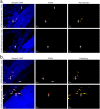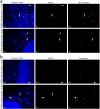Immune Cell Targets of Infection at the Tick-Skin Interface during Powassan Virus Transmission
- PMID: 27203436
- PMCID: PMC4874601
- DOI: 10.1371/journal.pone.0155889
Immune Cell Targets of Infection at the Tick-Skin Interface during Powassan Virus Transmission
Abstract
Powassan virus (POWV) is a tick-borne flavivirus that can result in a severe neuroinvasive disease with 50% of survivors displaying long-term neurological sequelae. Human POWV cases have been documented in Canada, the United States, and Russia. Although the number of reported POWV human cases has increased in the past fifteen years, POWV remains one of the less studied human pathogenic flaviviruses. Ixodes ticks are the vectors for POWV, and the virus is transmitted to a host's skin very early during the tick feeding process. Central to the successful transmission of a tick-borne pathogen are complex interactions between the host immune response and early tick-mediated immunomodulation, all of which initially occur at the skin interface. In our prior work, we examined the cutaneous immune gene expression during the early stages of POWV-infected Ixodes scapularis feeding. The present study serves to further investigate the skin interface by identifying early cell targets of infection at the POWV-infected tick feeding site. An in vivo infection model consisting of POWV-infected ticks feeding on mice for short durations was used in this study. Skin biopsies from the tick feeding sites were harvested at various early time points, enabling us to examine the skin histopathology and detect POWV viral antigen in immune cells present at the tick feeding site. The histopathology from the present study demonstrates that neutrophil and mononuclear cell infiltrates are recruited earlier to the feeding site of a POWV-infected tick versus an uninfected tick. This is the first report demonstrating that macrophages and fibroblasts contain POWV antigens, which suggests that they are early cellular targets of infection at the tick feeding site. These data provide key insights towards defining the complex interactions between the host immune response and early tick-mediated immunomodulation.
Conflict of interest statement
Figures




Similar articles
-
Tick Saliva Enhances Powassan Virus Transmission to the Host, Influencing Its Dissemination and the Course of Disease.J Virol. 2015 Aug;89(15):7852-60. doi: 10.1128/JVI.01056-15. Epub 2015 May 20. J Virol. 2015. PMID: 25995246 Free PMC article.
-
Early transcriptomic changes at the skin interface during Powassan virus transmission by Ixodes scapularis ticks.Front Immunol. 2025 Jan 13;15:1511132. doi: 10.3389/fimmu.2024.1511132. eCollection 2024. Front Immunol. 2025. PMID: 39872517 Free PMC article.
-
Interspecies co-feeding transmission of Powassan virus between a native tick, Ixodes scapularis, and the invasive East Asian tick, Haemaphysalis longicornis.Parasit Vectors. 2024 Jun 15;17(1):259. doi: 10.1186/s13071-024-06335-0. Parasit Vectors. 2024. PMID: 38879603 Free PMC article.
-
Powassan Virus: An Emerging Arbovirus of Public Health Concern in North America.Vector Borne Zoonotic Dis. 2017 Jul;17(7):453-462. doi: 10.1089/vbz.2017.2110. Epub 2017 May 12. Vector Borne Zoonotic Dis. 2017. PMID: 28498740 Free PMC article. Review.
-
Pathogenicity and virulence of Powassan virus.Virulence. 2025 Dec;16(1):2523887. doi: 10.1080/21505594.2025.2523887. Epub 2025 Jun 26. Virulence. 2025. PMID: 40545598 Free PMC article. Review.
Cited by
-
Tick-Borne Flaviviruses and the Type I Interferon Response.Viruses. 2018 Jun 21;10(7):340. doi: 10.3390/v10070340. Viruses. 2018. PMID: 29933625 Free PMC article. Review.
-
Transcriptional Immunoprofiling at the Tick-Virus-Host Interface during Early Stages of Tick-Borne Encephalitis Virus Transmission.Front Cell Infect Microbiol. 2017 Dec 1;7:494. doi: 10.3389/fcimb.2017.00494. eCollection 2017. Front Cell Infect Microbiol. 2017. PMID: 29250492 Free PMC article.
-
Tick salivary cystatin Iristatin limits the virus replication in skin of tick-borne encephalitis virus-infected mice.Parasitol Res. 2025 Jan 17;124(1):8. doi: 10.1007/s00436-024-08441-5. Parasitol Res. 2025. PMID: 39821815 Free PMC article.
-
Immunohistochemical Assays to Visualize Tick-Borne Flaviviruses at the Tick Feeding Site.Methods Mol Biol. 2025;2936:71-84. doi: 10.1007/978-1-0716-4587-1_9. Methods Mol Biol. 2025. PMID: 40512311
-
Powassan Virus Encephalitis.Infect Dis Clin North Am. 2022 Sep;36(3):671-688. doi: 10.1016/j.idc.2022.03.003. Infect Dis Clin North Am. 2022. PMID: 36116842 Free PMC article. Review.
References
-
- Goldfield M, Austin SM, Black HC, Taylor BF, Altman R. A non-fatal human case of Powassan virus encephalitis. Am J Trop Med Hyg. 1973. January;22(1):78–81. - PubMed
-
- Deibel R, Flanagan TD, Smith V. Central nervous system infections in New York State. Etiologic and epidemiologic observations, 1974. N Y State J Med. 1975. November;75(13):2337–2342. - PubMed
-
- Smith R, Woodall JP, Whitney E, Deibel R, Gross MA, Smith V, et al. Powassan virus infection. A report of three human cases of encephalitis. Am J Dis Child. 1974. May;127(5):691–693. - PubMed
Publication types
MeSH terms
Grants and funding
LinkOut - more resources
Full Text Sources
Other Literature Sources
Miscellaneous

